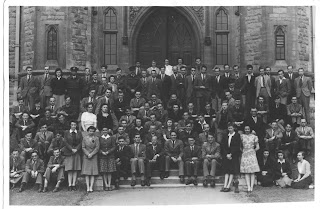At 5.30am heard a commotion of ducks and looked out the window to see what appeared to be all the ducks scurrying from the pond across the grass under the oak tree to somewhere known only to them.
This was to be a family history day. It began with a visit to Mathon Street where Robin and his family had lived.
The next stop was Malvern College where the Telecommunications Research Establishment was stationed from May 1942 until the end of the war. The archivist was not at the school until Friday but we were given permission to walk around and take photos.
We located the site where a photograph in our collection was taken during the war. The door has changed but otherwise the building is the same.
We then went to the Malvern Museum of Local History . They were unable to locate their folder on TRE but had some information in one of the display rooms. We purchased a book by a scientist who had worked at TRE and then had a look around the museum displays. Pale Manor was mentioned as another TRE location so we went back to the information office where Anne told us where to find the house.
After taking a photograph of the house we then started the search for other family connections.
At Cropthorne
we visited St Michael’s Church
The church was opened for us to see inside and we were told that Guise was a common name in the area.
There has been a church on this site since Saxon times with the current building more than 1,000 years old. It is a beautiful church and one wall includes part of a medieval mural that was whitewashed at one time and was unable to be fully recovered.
The next stop was Broadway to look for members of the Cotterill family.
The large Anglican church is another St Michael’s but does not have a cemetery. It was built in the mid 1800s. Further down Church Street is another Anglican church, St. Eadburgha's, built in the 1200s. An earlier church was built on the site during Saxon times. We spent some time exploring the cemetery unsuccessfully for Collier gravestones.
At the information centre in town we had once again been told that the name was common to the area but the inscriptions n the older stones were often worn and / or covered in moss. We therefore took some atmospheric photos before returning to the hotel.












No comments:
Post a Comment